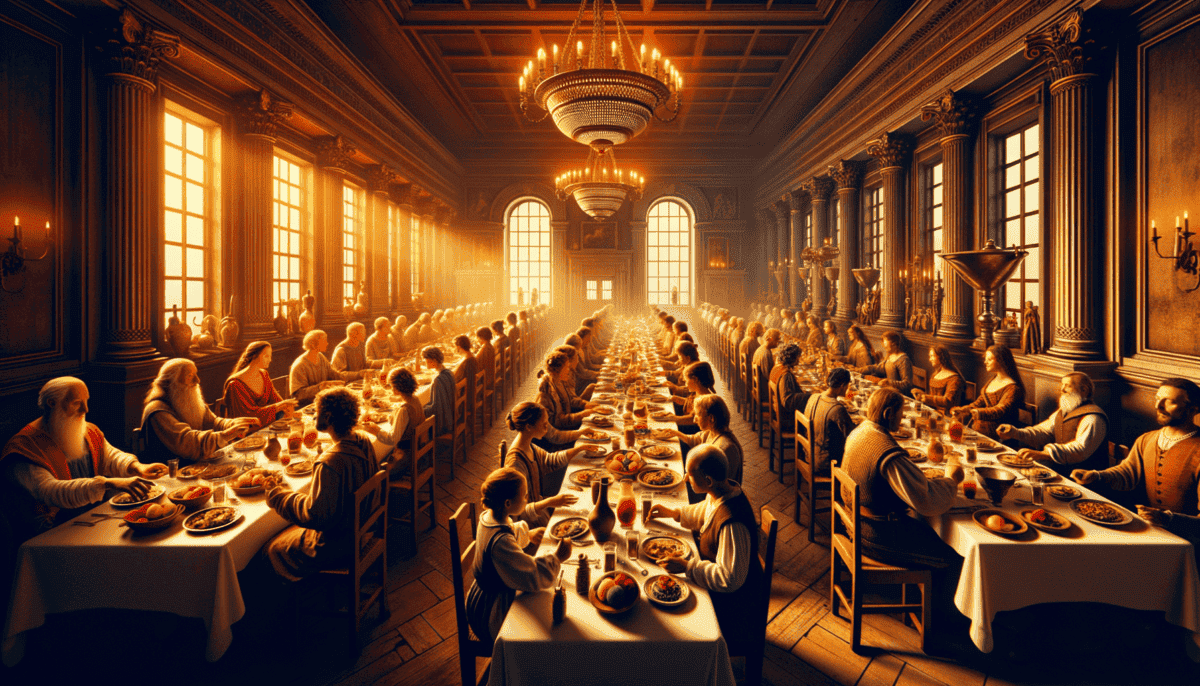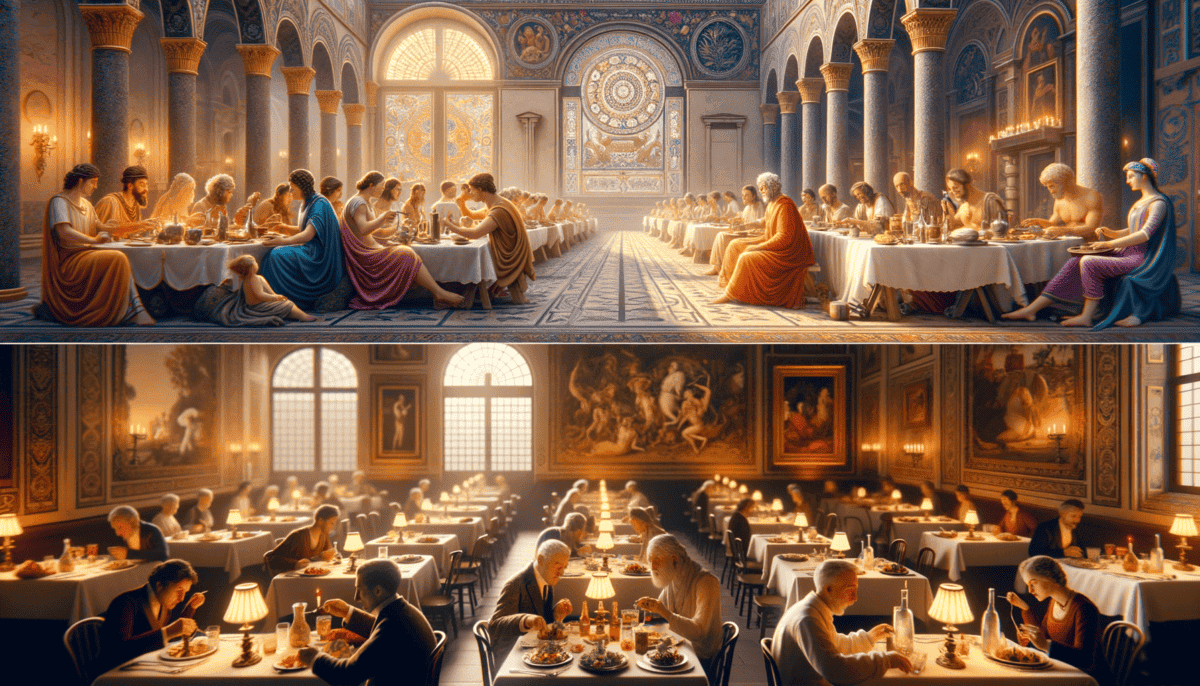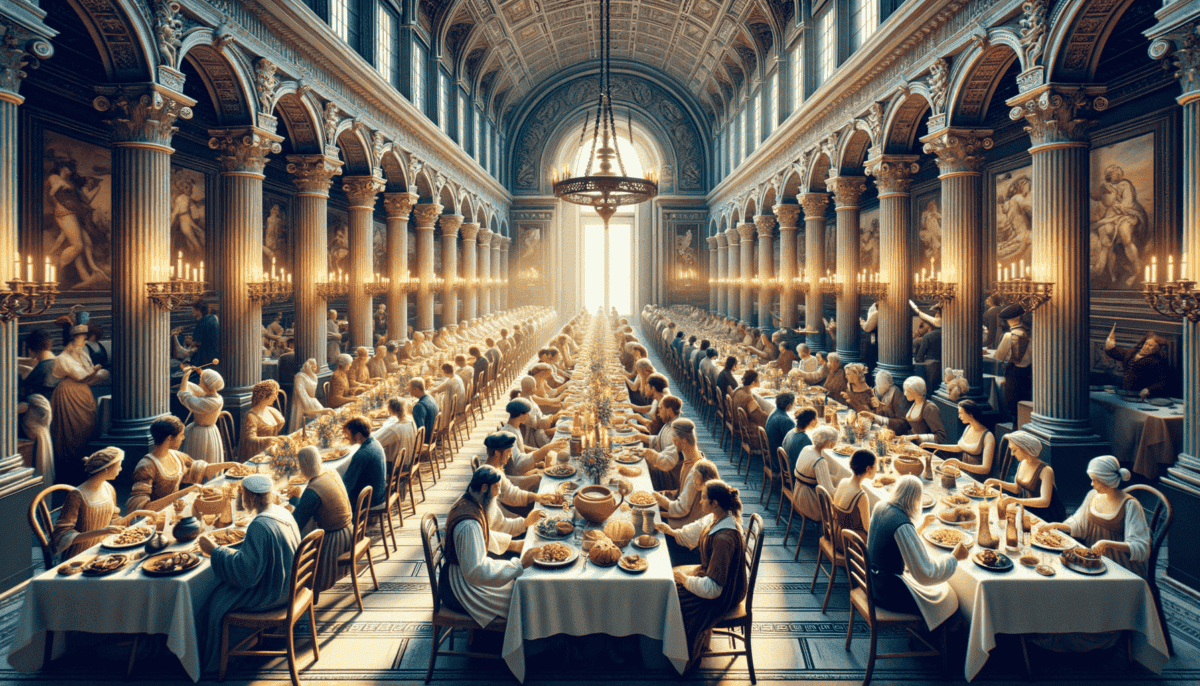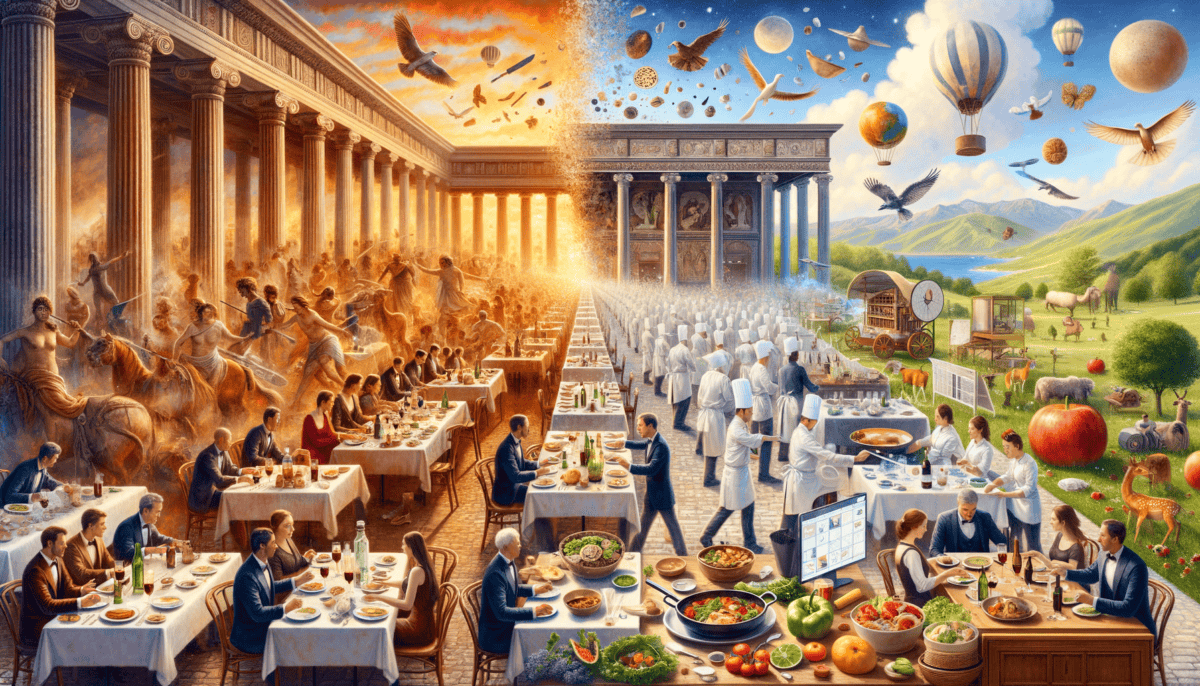The Ancient Feast
Marcus peered through the steam rising from the bustling kitchen. The year was 150 BC, and tonight’s feast at his master’s villa in Rome would be one to remember.
The young slave watched as cooks scurried around, preparing dishes fit for the gods. The smell of roasted meats and honey-drizzled figs filled the air. Music from lyres drifted in from the dining hall, where guests were already gathering on cushioned couches.
“Marcus!” called Helena, the head cook. “Take these oysters to the triclinium. And remember – serve from the left side!” Her face was red from the kitchen’s heat as she handed him a silver platter.
Marcus carefully balanced the platter as he entered the grand dining room. Guests wore flowing togas and sparkly jewelry. They chatted and laughed while slaves poured sweet wine into golden cups.
A Special Night
“Welcome, friends!” boomed Senator Claudius, the host. He wore a purple-trimmed toga that showed his importance. “Tonight we feast to honor the gods and celebrate our city’s latest victory!”
The room buzzed with excitement. These fancy dinner parties, called “convivium,” weren’t just about eating. They were where important people made friends and talked about big decisions for Rome.
“At a Roman feast, food feeds both the body and the spirit. We share not just meals, but ideas, stories, and friendship.” – Senator Claudius
The Feast Begins
Course after course arrived at the tables:
• Peacock eggs sprinkled with pepper
• Roasted dormice dipped in honey
• Wild boar stuffed with live birds
• Sweet cakes shaped like gods
• Fresh oysters from distant seas
Marcus watched in amazement as dancers twirled between the couches. A poet stood up to share new verses, and everyone clapped.
More Than Just Food
“You see, Marcus,” whispered Helena as they watched from the kitchen doorway, “these feasts tell stories about who we are. The foods we serve, the way we eat them, even where people sit – it all means something.”
Marcus nodded, understanding. The feast wasn’t just about filling hungry bellies. It was about showing power, making friends, and honoring traditions. Every bite told a story about Rome’s greatness.
As the night went on, the dining room filled with more laughter and song. Guests made promises and plans. New friendships formed over cups of wine and plates of exotic food.
A Night to Remember
When the last guests finally left, Marcus helped clean up the triclinium. His feet were tired, but his mind was full of everything he had seen.
“One day,” he thought, watching the stars through the window, “people will remember these feasts. They’ll want to know how Romans lived and ate and celebrated.”
He was right. The ancient feast traditions would shape how people ate and gathered for thousands of years to come. Every time friends share a meal today, they’re connecting to those long-ago nights of food, friendship, and celebration. ⭐
Royal Feasts and Castle Manners
Little Emma peeked through the castle kitchen doors. The year was 1242, and the great hall buzzed with excitement. Tonight, the king would feast!
“Mind those pies, child!” called Cook Martha, shooing Emma away from a tower of steaming pastries. The kitchen was hot and noisy, filled with the clatter of pots and the sizzle of roasting meat.
The Great Hall Prepares
Servants rushed around, spreading fresh rushes on the floor and hanging bright tapestries. At the high table, they set out special silver spoons and fancy cups. The king would sit in the middle, up high where everyone could see him.
“Emma!” called Sir William, the master of ceremonies. “Come help me check the seating. Remember – the most important guests sit closest to the king!”
“Where you sit at a feast shows how important you are. It’s like a map of who’s who in the castle!” – Sir William
New Ways to Eat
Emma watched as servants laid out the tools for eating:
• Sharp knives for cutting meat
• Wooden trenchers (like bread plates)
• Special spoons for soup
• Fine cloth napkins
• Salt in pretty holders
“Things are different now,” explained Cook Martha, wiping her hands on her apron. “People don’t just grab food with their hands anymore. We have rules for eating nicely.” ️
The Feast Begins
Trumpets blasted! The king entered the great hall in his finest clothes. Everyone bowed as he walked to his special chair. Musicians played happy tunes on drums and pipes.
“Bring forth the first course!” called Sir William. Servants paraded in with huge platters. There were soups in bread bowls, whole roasted pigs, and pies filled with birds.
Learning New Manners
“Watch closely,” whispered Martha to Emma. “See how the noble ladies and lords eat? They take small bites. They wipe their mouths with napkins. They share their cup with their neighbor.”
Emma noticed how different it was from the meals in the kitchen, where servants ate quickly with their hands. Here, everything was slow and proper. Each bite had rules.
More Than Just Food
The feast went on for hours. Between courses, jesters tumbled and told funny stories. A poet sang about brave knights and fair maidens. The king gave special gifts to his favorite guests.
“You see,” said Sir William, watching the happy crowd, “these feasts aren’t just for eating. They’re where we learn to be proper. Where we show respect. Where we make friends and solve problems.”
A New Way of Life
As the night ended, Emma helped clean up the great hall. She thought about all the new rules she’d learned. Using special spoons, sitting in the right place, eating slowly and carefully.
“These manners will spread,” she thought, picking up dropped napkins. “Soon everyone will want to eat like the people in the castle.”
She was right. The table manners born in medieval castles would grow and change, but they would never go away. They became part of how people showed respect and care for each other at meals.
A Renaissance of Taste
The aroma of exotic spices filled the air as Isabella crept down the grand palace hallway. The year was 1512, and Florence was alive with new ideas about food and dining.
“Careful with those plates, Isabella!” called Master Giorgio, the palace’s head chef. Gold-rimmed dishes sparkled in her arms as she carried them toward the dining hall. Tonight was special – the Medici family was hosting ambassadors from far away.
The Art of Food
“Look here,” Master Giorgio beckoned Isabella closer. On the kitchen table sat a swan made entirely of sugar! Its wings sparkled like diamonds. “This is what we call ‘dining theater’ – food that’s also art!”
“We eat first with our eyes, then with our mouths. Everything must be beautiful!” – Master Giorgio
New Flavors from Far Away
Isabella watched as cooks unpacked boxes from distant lands:
• Pepper from India
• Sugar from Arabia
• Chocolate from the New World
• Citrus fruits from Spain
• Rice from Asia
“The world is getting bigger,” smiled Sophia, the spice master. “And our food is getting more exciting!”
Setting the Perfect Table
In the dining hall, servants arranged everything just so. Shining forks lay next to sparkling knives. Crystal glasses caught the light from hundreds of candles. Fine linen napkins were folded into fancy shapes.
A Feast for All Senses
As guests arrived, musicians played sweet music on lutes and flutes. The room filled with the rustle of silk dresses and the murmur of many languages.
“Each course tells a story,” Master Giorgio explained as servants carried in the first dishes. “See? These little pastries look like ships – to honor our guests’ long journey!”
Dining as Theater
Isabella watched in wonder as each course became more magical than the last. There were eggs made of sugar, pies that released live birds when cut open, and jellies that shimmered like jewels.
“This isn’t just dinner,” whispered Sophia. “It’s a show of power, art, and knowledge all mixed together!” ✨
Sharing Knowledge
Between bites, guests shared stories of distant lands. They talked about new foods, new ideas, and new ways of cooking. Books about cooking and proper dining started to spread across Europe.
“Write this down,” Master Giorgio told Isabella, handing her a small notebook. “These recipes and rules will be important for many years to come.”
Changes Big and Small
As the evening went on, Isabella noticed how different this was from the feasts her grandmother described. Everything was more elegant, more planned, more artistic. People ate more slowly and talked more about their food.
She watched as an ambassador carefully used his new golden fork, trying to copy his Italian hosts. “The whole world is learning from each other,” she thought, smiling. “Even about how to eat dinner!”
With each new ship that sailed into port, with each new book about cooking, with each grand dinner party, dining was becoming more than just eating. It was becoming an art form all its own.
A Revolution at the Table
The streets of Paris buzzed with excitement. The year was 1786, and something new was happening. Marie looked up at the gleaming sign above the door: “Restaurateur – Come, all who hunger!” ️
A Special Place to Eat
“Welcome, mademoiselle,” smiled Monsieur Antoine, the owner. “Would you like your own table?” Marie nodded eagerly. This was different from the usual taverns – here, everyone got their own special space!
“And look,” he showed her a piece of paper, “this is what we call a ‘menu.’ You can pick exactly what you want to eat!”
“For the first time, regular people could eat like kings and queens!” – Monsieur Antoine
Changes in the Kitchen
In the busy kitchen, Chef Pierre was teaching his cooks new ways to work:
• Each cook had a special job
• Some made soups
• Others cooked meat
• Some just made sauces
• And some made pretty decorations
Special New Rules
Marie watched as servers carried plates to different tables. “See how we serve one person at a time?” Chef Pierre explained. “And everyone can eat when they want – not all together like before!” ⏰
Famous Food Makers
“Look who’s here!” whispered a server. A famous chef named Carême walked in. People turned to stare. Chefs were becoming as famous as artists!
“He makes food look like buildings and sculptures,” Marie learned. “He shows that cooking is an art!”
Everyone is Welcome
Marie saw all kinds of people in the restaurant:
A merchant sat near a writer. A lady in fine clothes ate next to a painter. A group of students shared a table near the window. Everyone could come and enjoy good food!
New Ways to Eat
“Would madame like her own fork and knife?” asked the server. Each person got their own clean plates and tools. This was much nicer than sharing!
“And here’s your napkin,” they added. “We change them for every guest.” Everything was clean and special. ️
Food for Everyone
As more restaurants opened, more people could try fancy foods. They didn’t have to be rich or know someone with a big kitchen. They just needed enough money for a meal.
“Yesterday I had soup just like the king eats!” Marie heard a young man tell his friend. “And tomorrow I might try something new!”
Ideas Spread Far
People from other countries visited French restaurants and loved the idea. They went home and opened their own restaurants. The idea spread like honey on warm bread!
Soon, every big city wanted its own restaurants. Chefs traveled to learn new recipes and ways of cooking. Food became exciting in a whole new way!
Marie smiled as she finished her meal. Thanks to restaurants, everyone could feel special when they ate. It wasn’t just about being hungry anymore – it was about trying new things and having fun!
A World of Flavors
The ship’s horn blew loudly as it pulled into New York Harbor. The year was 1892, and young Marco clutched his grandmother’s special recipe book close. They had traveled all the way from Italy to America!
New Foods in a New Land
“Look at all the different smells!” Marco said as they walked through the city streets. Chinese restaurants sat next to German bakeries. Italian pasta shops were near Jewish delis. It was like taking a trip around the world!
“Every family brings a new flavor to the pot!” – Marco’s grandmother
Sharing Special Recipes
Marco’s family opened a small restaurant. People loved trying their Italian food! Soon, other families started sharing their special foods too:
• Chinese families made yummy noodles
• German families baked soft pretzels
• Jewish families shared warm bagels
• Mexican families made spicy tacos
• Greek families grilled tasty gyros
Kitchen Magic
New machines made cooking easier and faster!
“Look at this!” Marco’s father showed him a new ice box. “Now we can keep food fresh longer!” They also got a big stove that could cook lots of food at once.
Mix and Match
Something fun started happening. People began mixing different foods together! A Chinese chef used Italian noodles. A German baker put Mexican spices in his bread. Everyone was trying new combinations!
Food on the Move
Trains and ships could now carry food across long distances. Fresh oranges from Florida went to New York. Spices from India came to London. Fish from Japan reached California!
“The world is getting smaller,” Marco’s mother said. “Now we can taste foods from everywhere!”
Learning New Things
People started taking cooking classes to learn about different foods. Marco’s grandmother taught others how to make pasta. Their neighbor Mrs. Chen showed them how to use chopsticks.
“Food brings people together,” Marco noticed. “Even if we speak different languages, we can share a meal!”
Writing It Down
People wrote cookbooks about foods from all over the world. Now anyone could try making dishes from far away! Marco helped write down his grandmother’s recipes so everyone could enjoy them.
Special Stores
New stores opened that sold foods from different countries. You could buy Italian olive oil, Japanese tea, and Mexican chilies all in one place!
“Remember when we could only get these spices back home?” Marco’s grandmother smiled. “Now they’re right here!”
A Tasty Future
As Marco grew up, he saw more and more foods mixing together. Each year brought new flavors and ways of cooking. The whole world was becoming one big kitchen!
“What will people cook next?” Marco wondered as he wrote down another new recipe in his book. Food was on an exciting adventure, and everyone was invited to taste it!
The Digital Dining Revolution
Sofia sat in her room, watching her smart tablet glow. On the screen, her friend Mei was cooking dinner – all the way from Tokyo!
“Add more sauce!” Sofia called out, making Mei laugh. They were having a virtual cooking party with friends from all over the world.
Kitchen of Tomorrow
Sofia’s kitchen looked very different from her great-grandfather Marco’s. Her family had:
• A smart fridge that orders food when it runs low
• A robot helper that stirs and chops
• A 3D food printer that makes fun shapes
• A garden pod that grows fresh herbs inside
• A screen that shows recipes in the air
Earth-Friendly Eating
“Look what I grew!” Sofia showed her friends the tomatoes from her indoor garden. Everyone was trying to help the Earth by growing food at home.
“When we take care of the Earth, it takes care of us!” – Sofia’s mom
Food Adventures
Sofia loved trying new combinations of foods. Yesterday, she had:
Korean tacos
Sushi burritos
Pizza with curry toppings
Ice cream with spicy chocolate
Everyone’s Welcome
“What should we make for dinner?” Sofia asked her family. They had choices from everywhere! Her tablet showed restaurants from every country, ready to send food right to their door.
Food for Everyone
Sofia’s school had special menus for everyone:
Foods for people who don’t eat meat
Foods for people with allergies
Foods for different religions
Foods that help the planet
The Future is Yummy
Scientists were making new kinds of food too! They grew meat in labs and made milk from plants. Some people even ate bugs for protein!
“The future tastes different,” Sofia giggled, trying a cookie made from cricket flour.
Connected Through Food
Every night, families around the world shared dinner together through screens. They taught each other recipes and told stories about their food.
“Food is like a bridge,” Sofia said. “It connects us all!”
A Feast for All
Looking back at her great-grandfather Marco’s old recipe book, Sofia smiled. She added her own recipes next to his. The book now had foods from every corner of the world.
From ancient feasts to medieval banquets, from fancy restaurants to digital dinners, food had always brought people together. And now, with new technology and caring for the Earth, everyone could share in the feast!
Sofia started another virtual cooking party. “What shall we make today?” she asked her friends on the screen. The adventure of food would never end!






